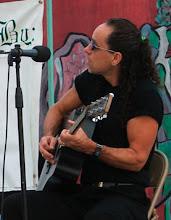Our last conversation was the first installment in this series within a series, and discussed the fundamentals of chord progressions (though more on that later).
Today, our task is to look at the fundamentals of chord construction (which will make sense out of those crazy chord names, like Cadd9 or Bm7b5 or Am11 or Gaug or Fmj7 or Emb9 or Dsus4. Sounds scary, but it really isn't.
Just like last time, we're going to start in the key of C (no sharps or flats), so our basic notes are, in musical order, C, D, E, F, G, A, B.
Remember, we can number each of those, also: C=1, D=2, E=3, F=4, G=5, A=6, B=7. We'll return to this idea later.
Now, we can build a chord off of each note, yielding us some kind of C chord, D chord, E chord, and so on. So let's start with building a C chord while using no sharps or flats (since those are our constraints due to being in the key of C).
C.
That's going to be our first note. Now, to build a chord from there, we employ the rules of "tertian" (or "tertial") harmony. That is, building the chord up (not down) in THIRDS, which is fancy-speak for "every other note". So if C, D, E, F, G, A, B are our notes, we choose C, then skip D, choose E, then skip F, then choose G. Then we stop because (for reasons we'll discuss later) we're building the most fundamental chord, which is called a triad - meaning it has just 3 notes.
So C, E, and G. That's it. And that yields what we call a C major chord, though we usually just say "C" and leave it at that.
Now notice we built that C chord off of the first, third, and fifth "scale degrees" (fancy-speak for where we applied a number to each letter above).
So now let's build a D chord. So, D, then skip E; F, then skip G; A, then stop. So our notes are D, F, A, which yields a D minor chord (written Dm). I'll explain WHY this is a minor rather than a major chord later. For now, let's just construct them.
Now, if we shift the numbers above so D=1 (since we were building a type of D chord), you'll notice that again, we built the chord off the first,third, and fifth scale degrees. You can also say, the one, three, and five.
Next is building the E. So, E, then skip F; G, then skip A; B, then stop. So our notes are E, G, and B, which yields an E minor chord (written Em). Again, we'll discuss WHY this is called a minor rather than major later.
Again, if we shift the numbers so E=1, we have built the chord using 1, 3, and 5.
Next is building the F. So, F, then skip G; A, then skip B; C, then stop. So our notes are F, A, and C, which yields an F major chord (spoken or written simply F).
Again, 1, 3, & 5.
And so on, through G, A, and B....which yield Gmajor (or just G), Aminor (or Am), and a weird one called B diminished (shortened to Bdim). All are, of course, 1, 3, & 5.
Now, when you hear someone talk about a seventh chord, it just means they've started with the basic triad and added one more note (after, 1, 3, & 5 comes....7).
So if you walk back through it, you'll see C = C, B, G....and then if you add a 7 you get:
C, E, G, & B....which is called C major 7 (written Cmj7). Then you have:
D, F, A, & C....which is Dm7
E, G, B, & D....which is Em7
F, A, C, & E....which is Fmj7
G, B, D, & F....which is G7
A, C, E, & G....which is Am7
B, D, F, & A....which is Bmb5 (spoken B minor flat five).
Note that funky G, which doesn't say major7 OR minor7. That's not an accident. We often call those "dominant 7", which we'll discuss later.
That almost wraps us up for the moment.
One last thing: We'll get into what happens if you keep building up (1, 3, 5, 7, 9, etc), but suffice for now to say that we can continue to build until we've used all 7 notes. And then we'll also discuss those crazy words like "suspended" and "augmented" and so on.
Cool, huh?
Next up? Scales!
====
If you'd like to support my work:
Monthly support: https://www.patreon.com/skinnydevilmusic or https://www.paypal.me/skinnydevilmusic (Pay What You Will)
One-shot support: https://www.paypal.me/skinnydevilmusic or www.venmo.com/David-McLean-47 (Pay What You Will)
If you'd like to support my work:
Monthly support: https://www.patreon.com/skinnydevilmusic or https://www.paypal.me/skinnydevilmusic (Pay What You Will)
One-shot support: https://www.paypal.me/skinnydevilmusic or www.venmo.com/David-McLean-47 (Pay What You Will)





No comments:
Post a Comment